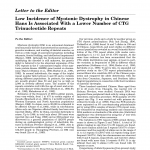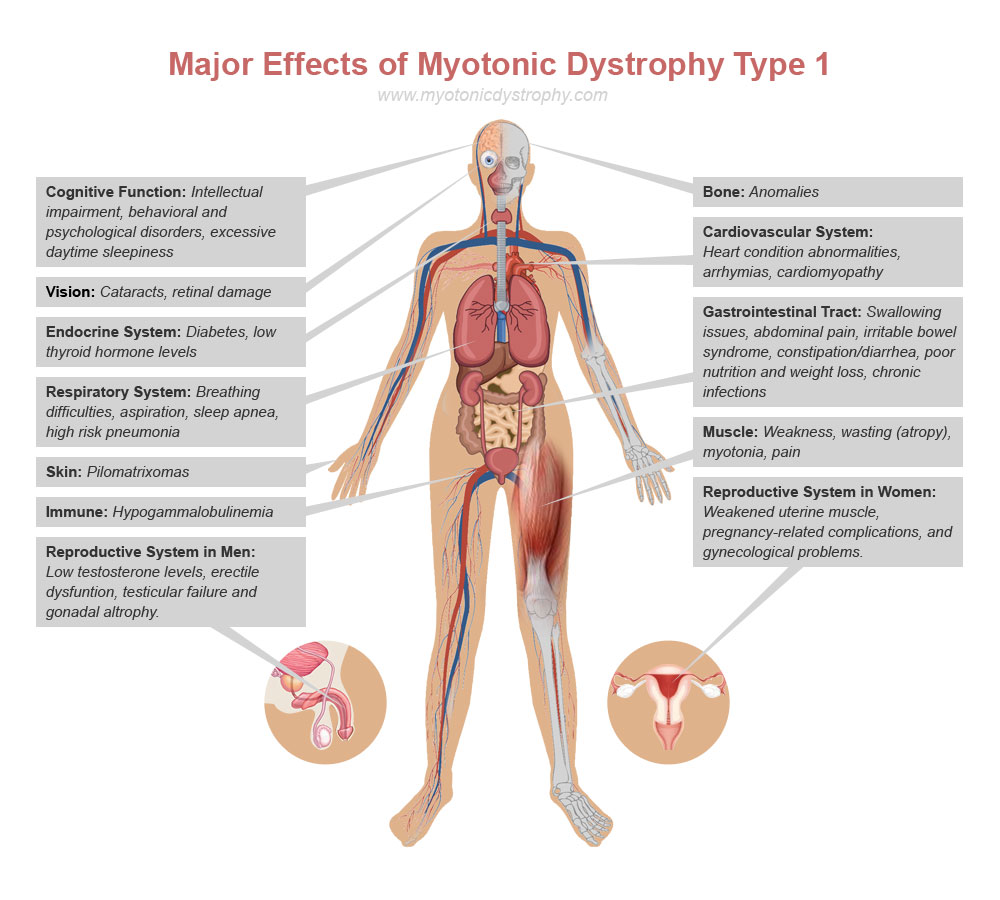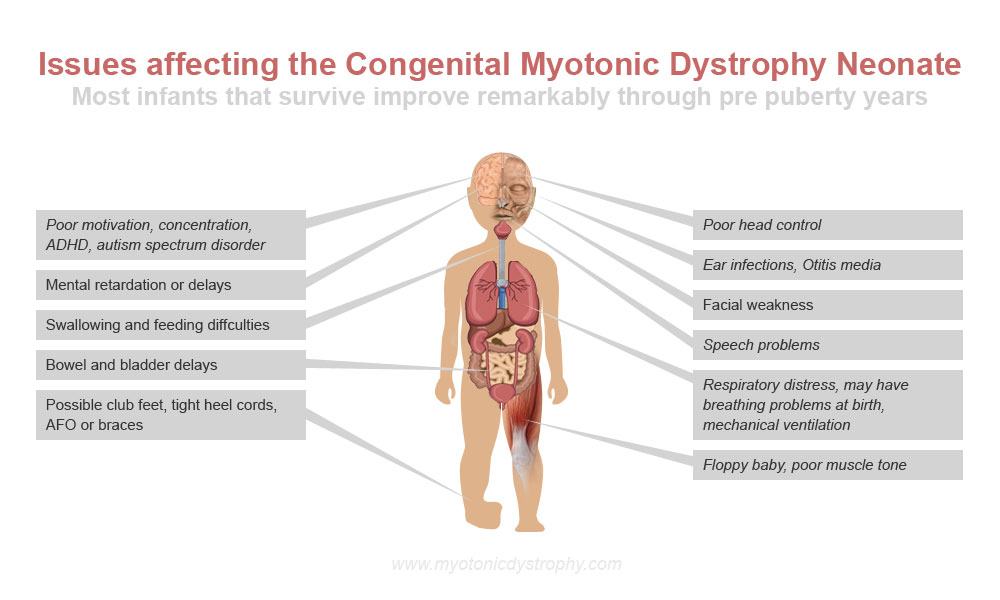The Blog. You’ve reached this site as you may be the one of nearly one million people affected by Myotonic Dystrophy Worldwide. This site aggregates and publishes all information on Myotonic Dystrophy Myotonic Dystrophy is a disease that is genetically based and inherited from one generation to the next. One out of two children of a person with myotonic dystrophy will most likely have the disease. Unlike most diseases, the symptoms that a person with this disease varies from person to person. Some people are just mildly affected others are severely affected. This makes it hard to tell you exactly how the disease will affect a particular person.
Four treatments that have potential have now surfaced about Myotonic Dystrophy. These are three approved Drugs by FDA and “off label use” may assist some people with DM1. (As always check with your Doctor) . The other is a drug that is not FDA approved in the USA for human use. Three off label uses have showed promise in mice studies but as yet there is no human data… In January of 2017 Ionis Pharmaceuticals stopped the trials of its DMPK-2.5Rx drug as it failed to show promise in the human trials. There are a few drugs that are in development to treat myotonic dystrophy with various approaches such as small molecules but not available now. There have been some studies in mice or human cells of currently approved FDA drugs but no human studies. A few are listed below.
===> Furamidine Study in mice and cells with Erythromycin
====>Colchicine (Colcrys, Mitigare), Fall 2019 a study in mice and human cells
====> Erythromycin study in cells and mice successfully pushes back disease in Mice
====> Actinomycin D study in cells and mice successfully pushes back disease in Mice
====> Phenylbutazone Ketoprofen Study in cells and mice pushes back disease in mice. NSAID type drugs. Ketoprofen would be strongly preferred. However, ketoprofen is no longer manufactured.
NOTE: These potential treatments are just that potential. NO studies in humans have been completed and reported. However, more and more information is available and here at this site you will find all that is published. You and your doctor should discuss these if you feel it warranted.
Myotonic dystrophy is a rare disease with an incidence of about one in 8000 in European and North American Populations. The incidence in Japan is approximately 1 in 20,000. In Africa and China the incidence is much lower.  The incidence of the congenital form of myotonic dystrophy is much lower with an incidence of 1/100,000. A more recent study by Campbell in Canada put the incidence of the congenital form at 1/47,000 That means that most doctors will not have a patient with the disease in their practice. Thus, many people are turning to organizations like the Myotonic Dystrophy Foundation for help and assistance.
The incidence of the congenital form of myotonic dystrophy is much lower with an incidence of 1/100,000. A more recent study by Campbell in Canada put the incidence of the congenital form at 1/47,000 That means that most doctors will not have a patient with the disease in their practice. Thus, many people are turning to organizations like the Myotonic Dystrophy Foundation for help and assistance.
Myotonic Dystrophy is generally classified into two types, adult and non-adult. The adult form is slowly progressive with the symptoms getting worse over time slowly. The congenital and juvenile forms have different symptoms and may get better until puberty when the adult version will begin to occur as well
Congenital: Appears at birth and is most severe (DM1 Only)
Juvenile: Appears after birth and in teen years
Adult: Appears in the late 20’s to early 40’s
Late Onset: Appears later after 40’s and generally mild
As a general rule the earlier the disease is becomes known or can be detected the more severe the symptoms will be. For example the congential form at birth will have the most severe symtoms including respiratory distress, mental retardation. The late adult onset may have no symptoms or cataracts only.
Myotonic Dystrophy is caused by an excessive number of CTG repeats on Chromosome 19. A “normal” number of Repeats is 5-38, Over 38 and myotonic dystrophy can occur. In the most severe congenital form the number of repeats is over 3,000. The disease has an effect called “anticipation” This means that the disease gets progressively worse with each generation. As a general rule 50% of the children will inherent the disease. It is particularly important that female members of the family in childbearing years be tested with a DNA test to find out if they have the disease. This can prevent the most severe from of the disease, the congenital form, from occurring.
There are now two types of myotonic Dystrophy recognized by the medical community. The third type that of Congenital and juvenile myotonic dystrophy has separate symptoms and onsets as should be considered a third type of DM.
DM1 is known as Type 1
DM2 is know as Type 2 also known as PROMM or “Proximal Myotonic Myopathia”
DM1 is caused by an expanded repeat of CTG on Chromosome 19
DM2 is caused by an expanded quadruplet repeat of CCTG on Chromosome 3
For more information on DM2 join the Yahoo group. This site concentrates on DM1
Myotonic Dystrophy is known as a multisystem disease. That means that the various types of tissue and organs are affected. Thus, the disease may affect the eyes, heart, and muscles. This is somewhat different than most diseases. Most disease will affect just one system. This change in the Chromosomes causes problems with individual cells in the body. Normal proteins and other items needed throughout the body are passed through the cells so they can circulate and end up where they are needed. In Myotonic Dystrophy some proteins and other items get stuck in the cells and can not circulate. So there are less of these proteins and the cells get clogged up with the proteins that can not get out of the cells. The good news is that now that the problem is known, there are treatments on the Horizon. Isis Pharmaceuticals in Carlsbad, CA is working on a drug (injection treatment) and has gotten great results in animal studies. Other researchers have looked at drug repositioning
The disease causes a lot of unusual problems in people with the disease. They may have trouble staying awake and have low energy levels. They may have depression. There may be hair loss or digestive problems. It is very hard to relay to people that this is a real disease and that the problems are real and not just a result of lack of motivation. In fact, lack of motivation is one of the results of the disease.
You also might be accessing the site to find out if you have the disease. The definitive test for the adult forms of Myotonic Dystrophy is the a Chromosome test but the grip test will usually allow you a quick and easy way to know if an individual may be afflicted with Myotonic Dystrophy. Affected individuals will not be able to open and close their hand rapidly and will have a characteristic grip. View this video
This site concentrates on information on myotonic dystrophy. If you are looking for information on Myotonic Dystrophy, there is an excellent book called Myotonic Dystrophy it is by Peter S. Harper , it is over 300 pages exclusively devoted to in-depth information on Myotonic Dystrophy. You may be able to obtain this book through an interlibrary loan from the local medical school. It is somewhat technical but a wealth of information on this subject. The third edition is now available. There is also a smaller booklet that is much easier to read called Myotonic Dystrophy “The Facts” You can order this book from the publisher or from amazon. I would highly recommend this book.
Congenital Myotonic Dystrophy
The discovery of the congenital form, CMD, is often a surprise to parents. When the baby is born and has problems and then a neurologist or other doctor may inform them that this is a possible cause. Its sometimes hard to find out about congential form of myotonic dystrophy. The symptoms of Congenital form are compeletely different from the adult form. So when you are looking at myotonic dystrophy sites and information the symptoms of DM1 as it is known do not apply in general to the congenital form. If you are accessing this page you may be trying to find more information about CMD. A birth of a CMD infant may bring two surprises to parents. One is that the baby is affected. The other that the mother is affected. Sometimes this comes as a complete surprise to the entire family. Sometimes the diagnosis occurs as the result of the infant dying or having a stillborn baby. See Parent Grieving Site. There is a number of posts on the Congenital form of this disease
![]() Here is link to the MDF website. THey have a great toolkit available with both professional and patient information. Click here for toolkit
Here is link to the MDF website. THey have a great toolkit available with both professional and patient information. Click here for toolkit
![]() Click here for a booklet from MDA in THE USA Click Here for booklet
Click here for a booklet from MDA in THE USA Click Here for booklet





Hi. I was born with myotonic dystophy. It runs in my family, and skips generations. Is there effective treatment available in other states, and countries other than Kentucky, and the U.S?
HI Mike, There is no drug yet that has been proven to cure myotonic dystrophy. The drugs available now is erythromycin which helped in a study with animals with muscle strength. It is an FDA approved antibiotic. Also some NSAIDS like ketoprofen may help. NO studies on any of this yet. See the articles in my blog
Richard
As of late my hands are hurting and also one of my fingers
Gets very tight to where I have to move it out straight. It
Is very painful Moving it back straight what would help with this
As it makes it very difficult to sleep and what is a good pain med to talk
For what I’m dealing with. Thank you hope to hear something
Soon.
Hi, Thanks for leaving a comment. there is a video library of Treatment information on the Myotonic Dystrophy Foundation Website on Treatments. Look for a Video Channel on You Tube http://www.youtube.com/user/MyotonicDotCom. The MDA also has a section on treatments on their IN Focus on Myotonic Dystrophy PDF. http://www.mda.org/sites/default/files/In_Focus_MMD.pdf
Let. me know about any treatment I have type 1 myotonic dysterphy